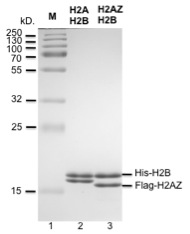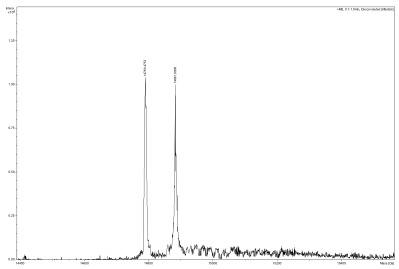|
|
Recombinant Histone H2A.Z-H2B dimers
Catalog # : EPX-07-RH
Source : Human
Expressed in : E. Coli
Quantity : 50ug of recombinant H2A.Z-H2B dimers at 1ug /ul
Background:
The histone variant H2A.Z is an evolutionary conserved histone variant that replaces conventional H2A in a subset of nucleosomes (1). The nucleosome is the basic unit of chromatin and consists of 147 base pairs of DNA wrapped around an octamer of core histones H2A, H2B, H3 and H4 (2). The histone variant H2A.Z has emerged as a key regulator of chromatin function and plays an essential role during mammalian development. H2A.Z is involved in transcriptional regulation, antisilencing, silencing, and genome stability (3).
Protein details:
Recombinant human histone H2A.Z-H2B dimers were produced in E. Coli as fusion proteins with an N-terminal FLAG or 6xHis epitopes, purified using FPLC and formulated in a storage buffer containing 20mM Tris-Cl pH 7.9, 1mM EDTA, 1M NaCl, 0.5mM PMSF and 1mM DTT. Protein concentration was determined by spectrometry.
Quality control:
Each lot has been evaluated by ESI-TOF analysis and 17% SDS-PAGE mini-gel (Tris-Glycine SDS, Acrylamide-bis (29:1)).
Application Notes:
For research use only.
Storage:
-80°C
Guarantee:
Products guaranteed stable for 2 years from date of receipt when stored properly.
Purity:
>98% purity by SDS PAGE.
Protein sequences: Flag-H2A.Z (Theoretical Mw: 14789.98) MDYKDDDDKLEAGGKAGKDSGKAKTKAVSRSQRAGLQFPVGRIHRHLKSR TTSHGRVGATAAVYSAAILEYLTAEVLELAGNASKDLKVKRITPRHLQLA IRGDEELDSLIKATIAGGGVIPHIHKSLIGKKGQQKTV
6xHis-H2B (Theoretical Mw: 14887.10) MGSHHHHHHGSPEPAKSAPAPKKGSKKAVTKAQKKDGKKRKRSRKESYSI YVYKVLKQVHPDTGISSKAMGIMNSFVNDIFERIAGEASRLAHYNKRSTI TSREIQTAVRLLLPGELAKHAVSEGTKAVTKYTSA
References: 1. Van Holde, K. E. (1989) Chromatin, 1-497. 2. Luger et al., (1997) Nature, 389(6648):251-60. 3. Redon et al., (2002). Curr Opin Genet Dev. 12(2):162-9. |
|---|
© 2011-2016 EpiGex. All rights reserved



